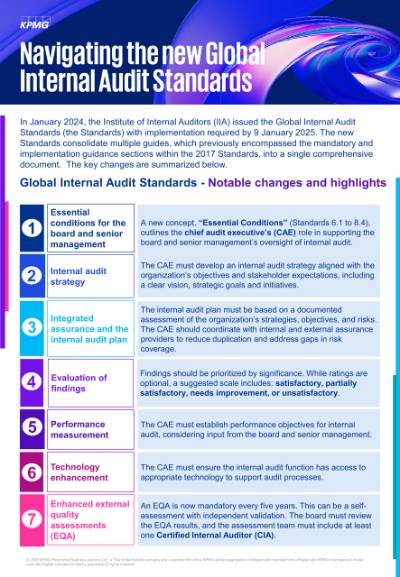EN | TH
In January 2024, the Institute of Internal Auditors (IIA) issued the Global Internal Audit Standards (the Standards) with implementation required by 9 January 2025. The new Standards consolidate multiple guides, which previously encompassed the mandatory and implementation guidance sections within the 2017 Standards, into a single comprehensive document. The key changes are summarized below.
Global Internal Audit Standards - Notable changes and highlights
A new concept, “Essential Conditions” (Standards 6.1 to 8.4), outlines the chief audit executive’s (CAE) role in supporting the board and senior management’s oversight of internal audit.
The CAE must develop an internal audit strategy aligned with the organization’s objectives and stakeholder expectations, including a clear vision, strategic goals and initiatives.
The internal audit plan must be based on a documented assessment of the organization’s strategies, objectives, and risks. The CAE should coordinate with internal and external assurance providers to reduce duplication and address gaps in risk coverage.
Findings should be prioritized by significance. While ratings are optional, a suggested scale includes: satisfactory, partially satisfactory, needs improvement, or unsatisfactory.
The CAE must establish performance objectives for internal audit, considering input from the board and senior management.
The CAE must ensure the internal audit function has access to appropriate technology to support audit processes.
An EQA is now mandatory every five years. This can be a self-assessment with independent validation. The board must review the EQA results, and the assessment team must include at least one Certified Internal Auditor (CIA).
Key considerations for implementation
- Conduct gap analysis against the new Standards to understand all necessary changes and identify the required preparations for their implementation
- Develop action plans to address gaps in alignment to the Standards. A formal action plan should include agreed-upon actions, designated action owner(s), and timelines, in line with the assigned priorities.
- The action plan or implementation plan should be communicated and disseminated to all impacted stakeholders, with periodic updates to ensure timely completion.
- Conduct training and maintain conformance with the new Standards. internal auditors should undergo training on the new Standards to understand the requirements.
- CAEs should organize a meeting with their board and senior management to discuss the ‘Essential Conditions’ outlined in the Standards.
Key takeaways for chief audit executive and audit committee
- What are the key changes to the Standards and how does the internal audit team align with the new Standards?
- Does the internal audit team have a clear and documented implementation plan for compliance with the new Standards?
- What resources (people, process, technology) are required to implement the new Standards and does the internal audit team have sufficient and necessary skills for compliance with the standards?
- What training programs or professional development opportunities will be needed for the internal audit team?
- Are the key stakeholders (board, audit committee, senior management) aware, fully informed and supportive of the implementation?
Key contacts
Why work with KPMG in Thailand
KPMG in Thailand, with more than 2,500 professionals offering Audit and Assurance, Legal, Tax, and Advisory services, is a member firm of the KPMG global organization of independent member firms affiliated with KPMG International Limited, a private English company limited by guarantee.




